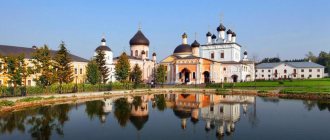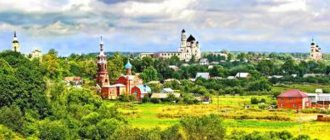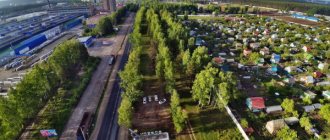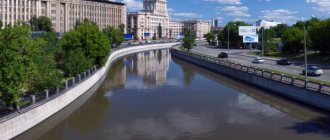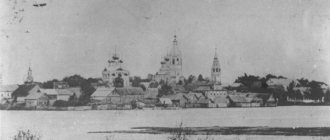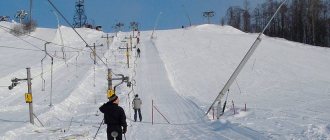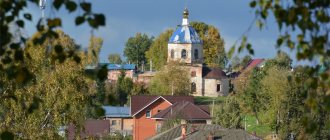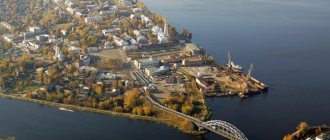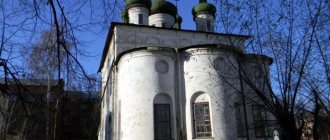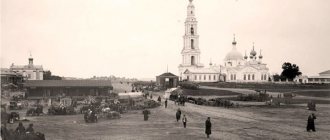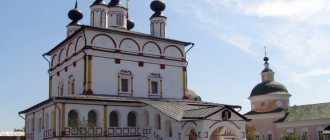History of Vyazma
The small but rich city of Vyazma is located in the Smolensk region and is a regional center with a population of 52 thousand people.
The date of origin of Vyazma is considered to be 1239, when it was first mentioned in historical sources. In fact, a settlement in this place arose at the end of the 11th century, and in 1239 it grew into an urban settlement. Vyazma is named after the river on which it stands. This river connected or “linked” three large water arteries: the Dnieper, the Volga and the Western Dvina. There are other versions of the origin of the city's name. For example, because it was built on clayey, “sticky” soil.
Vyazma was part of the Smolensk Principality until 1403, then it became part of the Principality of Lithuania. At the end of the 15th century it returned to the Russian lands. In the 17th century, Vyazma was engulfed in the events of the Time of Troubles; government troops and rebel detachments operated on its territory. Numerous battles with the French army took place here in 1812.
In Soviet times, the city was heavily destroyed during the Patriotic War and was under German occupation for a long time.
The historical and cultural significance of the city today lies in the fact that here you can get acquainted with the church architecture of the 12th-18th centuries. In the vicinity of the city there are museums - estates of the 18th century. The attractions of Vyazma also include numerous places where the events of the Patriotic Wars of 1812 and 1941-1945 took place.
Spaso-Preobrazhenskaya
The church was built in the first half of the 18th century on the site of a men's monastery destroyed by Lithuanian troops. The church was built at the expense of the local nobility and merchants. After the revolution, the new authorities transferred the church building to public organizations, which remained there until the end of the last century.
Top 10 most interesting sights of Vyazma
- John the Baptist Monastery. It began to be built in 1535. It suffered significant destruction during the wars of the 19th and 20th centuries. In the 1970s, restoration work began. Located at Dokuchaeva Street 45a.
St. John the Baptist Monastery - the main temple-attraction of Vyazma - Church of the Smolensk Icon of the Mother of God or Church of Hodegetria. Located next to the women's monastery of St. John the Baptist. Included in the UNESCO World Heritage List. The start date of construction is not precisely determined, presumably 1638.
- Holy Trinity Cathedral , built in 1635 (restored from the destroyed St. Nicholas Cathedral). In 1812 it suffered greatly from destruction. In the 1970s, restoration work began. Located at Nagorny Lane, 1.
- Arkadievsky Monastery. Located on Lenin Street, 11. It was founded in the second half of the 17th century on the territory of a wooden church of the 16th century. Today, the Spassky Church, which houses the city library and the Spasskaya Tower, is the only surviving part of the ancient Vyazma Kremlin.
- Museum of History and Local Lore. Located at Sovetskaya Square, 3 on the territory of the 18th-century Church of the Virgin Mary. The museum's exhibitions are located in eight halls and cover the historical period from ancient times to the 60s of the 20th century.
- The exhibition hall of the local history museum is located at 8 Vosstaniya Street in a merchant's house of the early 20th century. An art salon is open here.
- Museum of Sergei Yesenin. Located at Efremov Square, 3-22. A private museum containing the poet’s personal belongings and exhibits dating back to the time when he lived.
- In the very center of the city there is a monument to Mikhail Grigorievich Efremov , a hero of the war of 1941-45.
- On another central square of the city, Sovetskaya, there is a monument related to the modern sights of Vyazma, Russian Lapt.
- On 25 October 13 Street there is a statue - a monument to the actor Anatoly Dmitrievich Papanov. Once upon a time there was a house where the future actor lived.
A real fighter that Savitskaya herself flew on
What to visit : MiG-17 fighter. The monument depicts a jet plane taking off, leaving behind a trail in the form of a loop.
Where: In the park between Repin and 25th October streets
What's interesting : The winged machine is not a model, but a real fighter, on which Svetlana Savitskaya, the world's second female cosmonaut after Valentina Tereshkova and the world's first woman to go into outer space, underwent flight training in 1972-1973. She is also the only woman to be twice awarded the title of Hero of the Soviet Union. She holds 3 world records in group parachute jumps from the stratosphere, 15 world records on jet aircraft, and in total Svetlana Evgenievna has mastered and tested about 20 types of aircraft.
Architectural objects and monuments of Vyazma
In the city center, not far from Soviet Square, on the streets of Kronstadt, Hegel, Paris Commune, Karl Liebknecht, Herzen, you can see monuments of urban architecture of the 18th-19th centuries. In the suburbs of Vyazma, namely 37 kilometers from the city, there is a museum-reserve, the former estate of the Griboedov family and now the Khmelit Museum. The poet Alexander Griboedov also visited here.
The estate was built and flourished in the 18th century. In the second half of the 19th century it was in a deplorable state. The new owner, Count Pyotr Alexandrovich Heyden, restored it. During Soviet times, the house suffered greatly from destruction, looting, and fire. Restoration began in the 60s. The museum opened in 1988.
The main exhibition includes objects of art and everyday life from the late 18th – first third of the 19th centuries. Temporary thematic exhibitions are also held. In 2002, a museum of Admiral Pavel Stepanovich Nakhimov, a native of the Smolensk region, appeared on the territory of the estate. It is located in the building of the former Griboedov greenhouse.
The admiral's workplace has been recreated here, photographs and archival documents have been collected. On the second floor of the museum there is an exhibition of paintings depicting battles in which Pavel Stepanovich participated, as well as models of warships. In the immediate vicinity of the Khmelita estate there are several more historical architectural monuments.
These are the Transfiguration Church of the late 18th century in the village of Grigorievskoye, the Church of the Ascension of 1793 in the village of Torbeevo, the garden and park complex of the 17th-19th centuries in the village of Lipitsy, the Akhtyrskaya Church of 1819 with preserved paintings in the dome and the chapel in the village of Pigulino, the Trinity Church of 1820 in the village of Fedyaevo, the Sheremetev estate of the mid-19th century in the village of Shirokoe.
Within a radius of 20 km from Khmelita, you can visit the Baryshnikov estate of the 18th - 19th centuries with preserved religious, residential, utility buildings, and partly a park.
It is located in the villages of Nikolo-Pogoreloe and Aleksino. The estate of Count Panin in the village of Dugino is a well-preserved park, cascading ponds, as well as partially extant outbuildings and two wings of the palace.
Vvedenskaya Church
The date of construction is considered to be the mid-18th century. Initially, a two-story church was built, which was later completed with a bell tower and an additional floor. It served the parishioners well until the mid-thirties of the last century, until it was decided to close it and transfer the building to city needs. Church services resumed only 60 years later, at the end of the last century.
Historical monuments of Vyazma
Vyazma, whose sights preserve the memory of the events of the Great Patriotic War, remembers and honors its heroes. In the center of the city there is an Eternal Flame on Efremov Square and a monument to General Efremov. Also in 1989, a Stele in memory of those killed in the Great Patriotic War was installed on Yamskaya Street.
Another war, the Patriotic War of 1812, is dedicated to the Monument to the Valiant Ancestors. It is located near the Pobeda cinema, which is located at Lenin Street, 13. This is a figure of a double-headed eagle tearing the French flag.
It was first erected in 1813, then suffered greatly during Soviet times. Restored and reopened in 1962 in honor of the 150th anniversary of the Battle of Borodino. More recent attractions include the monument to the scientist Konstantin Eduardovich Tsiolkovsky. Located in a park on Sverdlova Street, built in the 60s of the 20th century.
Holy Trinity Cathedral
On the highest Cathedral Hill in the city, a wooden church was built in the 16th century, which was visible from every corner of the fort. About a hundred years later, a new stone cathedral was erected on the site of the outdated church, which regularly served its parishioners until 1928. This year it was thoroughly destroyed, but on the eve of the second war, in 1941, it was restored. The main relic of the cathedral, the icon of the Iveron Mother of God, constantly attracts pilgrims from all over Russia.
Interesting museums in Vyazma
| Name. | Description. | Address. |
| Museum of History and Local Lore. | Here you can trace the history of the city from ancient times to the 20th century. The events of the War of 1812 and the Great Patriotic War are covered in the most detail. | Sovetskaya Square, 3. |
| Museum of Sergei Yesenin. | The only museum in the Smolensk region dedicated to the poet. There are exhibits related to the life and work of the poet, as well as the history of the 20th century in general. | Efremov Square, 3-22. |
| Museum of the Unknown Soldier. | A modern museum dedicated to the events of the Great Patriotic War. | Komsomolskaya street, 16 |
John the Baptist Monastery
This monastery is considered one of the largest in the Smolensk region, organized with the highest permission of Ivan the Terrible himself in the 16th century. The wars that did not pass by caused great damage to the buildings of the complex, which had to be restored for a long time. The last restoration ended in 1976. After which male monks settled in the monastery, and five years later it became a purely female monastery.
Temples and cathedrals of Vyazma
Vyazma is rich in beautiful unique temples, churches and cathedrals:
1. The Church of the Hodegetria of Smolensk of the 17th century is a unique temple located at Dokuchaev 48a on the territory of the St. John the Baptist Convent. One of the seven surviving three-tent churches in Russia, it is the symbol and pride of Vyazma.
https://www.youtube.com/watch?v=fGVaksG-CAs
The exact date of the start of construction is unknown, it is mentioned in sources for the first time in 1673, but construction most likely began earlier. This is a three-roofed, very elegantly decorated church. The patterned style gives it lightness and airiness.
The church is located on the territory of the John the Baptist Convent, which dates back to 1536, when a cell was built on this site, and then in 1542 a wooden church in honor of John the Baptist - the basis of the future monastery. In its modern restored form, the temple was opened in 1990, first as a men's monastery, and since 1995 as a women's monastery.
In addition to Hodegetria, the monastery complex includes the Church of the Ascension and the Church of the Sign of the Mother of God.
2. At 4 Strakhovoy Lane there is the most beautiful Church of the Transfiguration of the Lord or the Transfiguration Church. It was erected in 1736 on the site of the Spassky Monastery, which was devastated and destroyed.
Like many other historical objects of the city, the church suffered during the war with the French of 1812 and during the war of 1941-45 and during the rule of the Bolsheviks. The church was reopened for visits and services in 1998.
3. The Church of Peter and Paul is located at 3rd International Lane, 1. It was first mentioned in sources in 1627. Then it was a wooden temple, which existed until 1805. Then a stone temple was erected on this site, which has survived to this day. Restoration of the temple began in the 1980s, but was not completed. It is not currently active.
4. Yamskaya Church on Krupskaya Street. Unlike the Church of Peter and Paul, it was nevertheless restored and opened to parishioners; now restoration work is still underway in the church. It was also first mentioned in 1627. The stone church was erected in 1763.
5. Church of the Nativity of the Blessed Virgin Mary on Sovetskaya Square, 3. In its current form, it was erected in 1728 on the site of a wooden church. The building was heavily damaged during the War of 1812. By the 100th victory in the war with Napoleon, funds were allocated for its restoration.
The temple was again destroyed during the Great Patriotic War. After renovation, a cinema was located here . Now the church is not operational; the building houses a local history museum. However, negotiations are underway to return it to the disposal of the Russian Orthodox Church.
6. Catherine's Church on Dokuchaev Street in the center of the Catherine Cemetery. An interesting monument of religious architecture in the Baroque style. The church was built in 1776. Now the building has not been restored and is in disrepair.
7. The Holy Trinity Cathedral is located at Nagorny Lane, 1 Back in 1015, the wooden St. Nicholas Church was built here. In 1635 it was renamed Trinity Cathedral. In 1676, a stone temple was built in its place. In the 20th century, before the 1941-45 war, the cathedral was used as a warehouse. After the war, restoration work began, and the temple was returned to the Russian Orthodox Church. Today it is a beautiful building in the classicist style.
8. On the territory of the Arkadievsky Convent, the Cathedral of the Origin of the Venerable Virgins of the Holy Cross , which in its modern form was built in 1762, has been preserved.
The founding date of the church on this site is considered to be the mid-16th century. The cathedral was damaged by fire in 1812 and then restored. During the Soviet years it was closed and empty. In the 1970s and 80s, the city library was located here. Now transferred to the disposal of the Church.
9. The convent itself is located at Lenin, 11. It was founded in the middle of the 16th century, when the Church of the All-Merciful Savior was built here. In the middle of the 17th century, the Ilyinsky Monastery was organized at the temple. It was closed in 1779. Reopened as a women's in 1832.
During Soviet times, most of the buildings were closed and dismantled.
In addition to the above-mentioned attractions, in Vyazma you can also see modern churches. This is the Church of Alexander Nevsky, the Church of Sampson the Host, the Church of Gerasim Boldinsky.
Church of Hodegetria
One of three churches of amazing beauty on the territory of the St. John the Baptist temple complex. The white-stone church with three domes lined up in a row over openwork kokoshniks was built in the 17th century; a similar architectural design can be found in Uglich and Putinki. The last restoration was carried out in 1994.
Parks and gardens of Vyazma
The city Central Park of Vyazma begins at Efremov Square. There are attractions, cafes, and playgrounds here. It has a length and not always a happy story. During the war, executions of local residents by German soldiers took place here. Then, in the post-war years, the park was improved: there were carousels, a shooting gallery, billiards, and an orchestra played.
In the 90s, the place was again abandoned and unkempt. Now the park again welcomes city guests and Vyazmich residents. Nakhimovsky Park is located between Lenin, Baumanskaya and Pokrovsky streets. The park has benches for relaxation and a fountain.
Where to go in Vyazma with children
City park in Vyazma
Vyazma is not Orlando with its Disneyland or a seaside resort with water parks and attractions. But this is also its advantage, because nothing will distract your children from studying the history and architectural sights of Russia. There is a special atmosphere here that children need to plunge into from time to time to take a break from the benefits of digital civilization. However, children are children, so they still sometimes want to ride on carousels and other attractions. For this purpose, in Vyazma there is a City Park, where, by the way, adults can also find entertainment, for example, in the form of a shooting range and a game of darts.
While your child is running around the park, you can relax in a cafe or restaurant. The park is located between Cosmonauts and Lenin streets, and is quite easy to find. In any case, local residents will always tell you how to get there.
Modern objects interesting to visit
Vyazma, whose attractions are not limited to ancient monuments and churches, also has many modern interesting art objects. In 2012, the Monument to Russian Laptya was erected on Sovetskaya Square, which is very popular among citizens and tourists.
Near the Central District Library at 11 Paris Commune Street you can see magical phoenix feathers. The monument represents an open book from which a phoenix grows. On each of its pens are written the names of people - artists, musicians, writers - who contributed to the history and development of the city.
In one of the courtyards on Lenin Street you can see the figure of a baby elephant - this is a former fountain. For a long time it was neglected. But now the fountain bowl and the elephant itself have been restored by local residents. Water pours out of his trunk again.
On the territory of the Cossack Institute at Lenin, 77 you can see a newly built monument to the Cossack ataman Matvey Platov, who lived in 1753-1818 and heroically participated in many battles and battles of the Russian Empire. In 2013, a monument to the Fallen Doctors was built on Yamskaya Street . It is a memorial stone and is dedicated to military doctors.
City holidays
The main holiday is City Day - it takes place every first weekend of summer.
In 2022, Vyazma celebrated its 778th birthday. On this day, festive events took place.
Also, events take place on all Russian holidays - New Year, Victory Day, Knowledge Day, etc.
Despite its modest size, Vyazma is a worthy place for a tourist visit. The sights of the city will be of particular interest to people who are interested in history and studying the Second World War - here you can find several monuments to heroes, memorials and museums.
Watch the video and pictures that describe the sights and traditions of Vyazma:
Excursion routes
The most popular excursion route is a visit to the Khmelita Museum-Reserve and a sightseeing tour of the city of Vyazma. The sights that can be seen by choosing this route are, first of all, the Griboyedov estate, located 37 kilometers from the city, as well as the most beautiful churches of Vyazma - the Trinity Cathedral and the Cathedral of the Mother of God Hodegetria.
In addition, guests visit the local history museum, get acquainted with the history of the city, and can see the city’s most beautiful churches and monuments related to the events of the Great Patriotic War.
Soviet square
The main city square, around which the main architectural monuments of the city are located, faces the Vyazma River, to which there is a wide descent. Initially, the square was called Torgovaya and used to host large and noisy fairs; now the main citywide events, parades, city day and others are held here.
Top 5 places suitable for holidays with children
Vyazma, whose sights will captivate mainly adults, is also a place for interesting and comfortable pastime with children:
- In the city center, next to Efremov Square, there is a Central Park with attractions, playgrounds and cafes.
- Here, on Efremov Square, you can stroll by the general’s monument and see the Eternal Flame.
- At Sovetskaya Square 2a there is a theater for young spectators.
- For older children, it will also be interesting to visit the Museum of History and Local Lore at Sovetskaya Square, 3.
- The Bastion entertainment sports club is located at Zavodskaya Street, 29.
Vyazma on the map of Russia
The city is located in the west of Moscow, the distance from the capital is 210 km. It is the administrative center of the district of the same name in the Smolensk region. The nearest cities are Smolensk, Yaroslavl, Kaluga, Rzhev.
Please note: the city is located on the Old Smolensk Road - it connected Moscow with Europe.
You can get there from Moscow:
- by train or commuter train from Belorussky railway station;
- by bus from the metro stations “Novoyasenevskaya”, “Tushinskaya” or “Teply Stan”;
- by car along the Minsk highway.
Those who like to relax in Crimea will be interested in an article about the sights of Alushta.
Self-guided walking route
- You should start exploring Vyazma from Efremov Square; here is the monument to Efremov and the Eternal Flame.
- Next, you should go up to Lenin Street and see the Monument to the Valiant Ancestors.
- Here, at Lenin, 13, stands the famous Spasskaya Tower.
- Next you need to go to Nagorny Lane, 1 and linger in the beautiful Holy Trinity Cathedral.
- The route continues to Sovetskaya Square, where there is a modern monument to Lapt.
- Next to it, at Sovetskaya Square, 3, is the Museum of History and Local Lore.
- The last attraction of the route is located at some distance, namely 1.5 kilometers. A 20-30 minute walk will take you to Dokuchaev Street. Here, at addresses 45a and 48a, are the St. John the Baptist Monastery and the beautiful unique Church of Hodegetria.
Interesting Facts
Vyazma, whose attractions are varied and numerous, is also interesting because it is the birthplace of many famous figures. Among them is Alekseev Mikhail Vasilievich, a Russian military leader, participant in the Russian-Turkish, Russian-Japanese and First World Wars.
Vyazma is the birthplace of Anatoly Dmitrievich Papanov, a Soviet and Russian theater and film figure. Pavel Stepanovich Nakhimov, a Russian admiral, was born in Vyazemsky district. In 2009, the city was awarded the honorary title City of Military Glory. In the Vyazemsky district, on the Rykhlovo estate, the granddaughter of Alexander Sergeevich Pushkin, Vera Aleksandrovna Mezentsova, is buried.
An unusual place in the Vyazemsky district is Semlevskoye Lake in the village of Semlevo. According to legend, Napoleon hid his treasures in it when he left Moscow.
The city of Vyazma and its attractions will be of interest to lovers of the history of the Patriotic War of 1812 and the Great Patriotic War, iconic modern and ancient architecture. In Vyazma, city buildings from the 18th – 19th centuries have also been preserved. Also of exceptional interest are the surrounding areas of the city, where there are estates and parks from the 18th century.
Article design: Vladimir the Great
Monument to General M. G. Efremov
The monument is dedicated to the general of the Soviet army during the Second World War, army commander Efremov. Having been seriously wounded and not wanting to burden his comrades or fall into Nazi captivity, he shot himself. The monument, designed by sculptor Vuchetich, was made in 1946 and installed in the city square.
